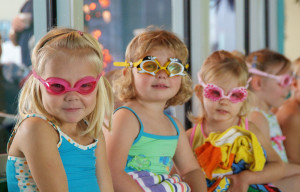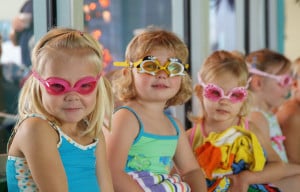
Whether you are a beginning swimmer, have a child that's learning to swim, or have been swimming for years, finding an ideal pair of goggles can be somewhat challenging. The last thing a swimmer wants to deal with is water leaking into their eyes - especially if they are just learning how to swim! Options for goggles are endless, and depending on whether you are swimming for leisure purposes, competitively, indoors or outdoors can impact what style may be best for you. While you will want to take all of that into consideration when picking out a pair of goggles, we would like to provide some key things to look for to ensure that the pair of goggles you purchase will fit properly.
EYE PIECE
When finding the right fitting goggle, it is important to understand the different parts. The first and main piece would be the eye piece. You want to make sure it is sized appropriately to fit around the eye. If it is too big, water will leak through the areas where it doesn't fit snug against the face. If the eye piece is too small, it will push on the eye and cause bulging, leading to an uncomfortable experience. Another option for the eye piece is adding a tint of color. A darker tinted pair of goggles will work indoors and outdoors, although they won’t block out the sun as well as a mirrored tint. A lightly tinted or clear eye piece will be better in low light situations, ideal for a dim indoor pool. However, note that not all colored lenses have UV protection. Parents often ask if the colored lenses bother children. I have never heard a child complain about colored lenses or say they can’t see.
NOSE PIECE
The nose piece holds the two eye pieces together and can be adjustable or non-adjustable. If you are adjusting the nose piece for a small child, make sure to adjust it first and then try the goggles on the child. Sometimes, when the nose piece is adjusted smaller, the extra length can irritate the skin and get into the way of the eye piece suction. However, a solid nose piece can make the eye pieces too far apart and the goggles won’t suction correctly to the eyes, causing water to leak in.
STRAPS
Goggles come with different types of straps, with the most popular being one strap that splits in the back. Goggles with just one strap tend to put a lot of pressure in one spot and can eventually cause pain. Two straps or straps that are split tend to stay in place better when you put one strap higher than the other; this also gives swimmers with longer hair a place to put a pony tail. Straps should always be placed at eye level or above. You also want to look at how thick the straps are to get an idea of how long they will last. Since the straps get tugged and pulled on a lot, a thinner strap will most likely break first. Lastly, there are different ways to adjust the goggle straps; some pairs have adjustments in the back, on the side, and others are on the eye piece. The best adjustment is going to be based on who is wearing them. For example, longer hair may get tangled with a plastic piece on the side or the back of the strap. Also, if the goggles adjust by pulling the straps, you will want to look at how long the plastic piece can withstand the pressure.
So, when looking at goggles the options are endless! What you are looking for is based on the individual and personal preference. Things to keep in mind are the size and shape of the eye pieces, color of the lenses, and if they offer UV protection. You also want to check if the nose piece is adjustable, what the straps are like, and how they adjust.
Swimtastic Topic Expert: Ashley Bossell, Swimtastic of the Fox Cities, WI




